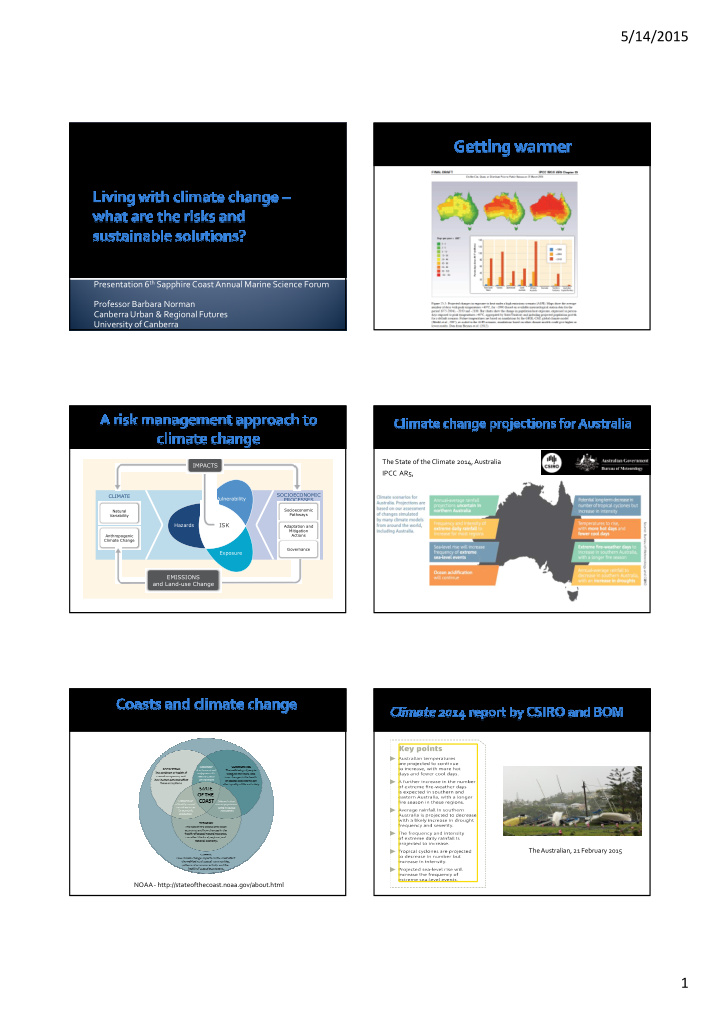



5/14/2015 Presentation 6 th Sapphire Coast Annual Marine Science Forum Professor Barbara Norman Canberra Urban & Regional Futures University of Canberra The State of the Climate 2014, Australia �������� IPCC AR5, �������������� �������� " !����#�!���� ���������� �������������� ��� ��!� ��������� "����#�!���� %�&����� ���$� ��������������� ����������� �������������� �������� �!������������� ����������� �'��� ��� ���������� ��������( ���������� The Australian, 21 February 2015 NOAA - http://stateofthecoast.noaa.gov/about.html 1
5/14/2015 The science indicates that by 2030 the region may experience: � increased temperatures (virtually certain) � changes in the pattern of rainfall (likely), � further sea -level rise (virtually certain), � an increasing risk of coastal inundation and erosion (highly likely) and � an increasing risk of bushfires (highly likely)’ (Norman et al 2013, South East Coastal Adaptation, NCCARF) http://www.exergypower.com.au/CLIMATECHANGE.HTML � Responding to climate change Mainstreaming the response to � � Mitigation and adaptation climate change (floods, fire, heat, storms) � Maintaining public access � Accommodating and servicing � Sea country plans and an ageing and retired population Indigenous engagement Space for adaptation and green � Providing and maintaining � infrastructure smart coastal development and infrastructure for urban growth Urban settlements – renewable � energy, smart infrastructure, � Maintaining healthy coastal and green buildings, biodiversity marine ecosystems under pressure � Coast has a right (just like the water in the rivers) � Identify clearly who is responsible � Regional collaboration � Advisory and/or decision making roles � Accountability and transparency � A precautionary approach 2
5/14/2015 Principle 1 An integrated approach should be adopted for sustainable regional and local 1. Scenario planning for risk management planning (social, economic, environmental and cultural). Principle 2 2. Give the coast rights (public interest doctrine) The precautionary principle to decision making should be applied to the location of new and redeveloped urban settlement and infrastructure and other relevant decisions, particularly where environmental risk currently or potentially exists. 3. Continuing conversations with the community Principle 3 Risk management approaches should be incorporated into local and regional strategies for coastal settlements responding to climate and environmental change 1. Integrated regional coastal planning including progressive learning from experience to ensure adaptability. Principle 4 1. Take a precautionary approach in coastal Appropriate forums should be established at the regional level to enable collaboration across institutions at the local and regional level . Governance planning decisions mechanisms that facilitate intergovernmental agreement on policy directions (shared vision) and integration of policy decisions (implementation) are fundamental to coastal adaptation. Principle 5 There should be an ongoing process of community engagement . This needs to be � Social equity informed by the latest science, in developing and regularly reviewing coastal urban considerations for the plans to gain community support most vulnerable Principle 6 The skills and knowledge of regional and local communities should be connected � Adaptive capacity by relevant organisations to provide a foundation for long-term research, co- variable production of knowledge and monitoring of coastal urban futures. Regional communities and practitioners could engage on a periodic basis with Australia’s leading scientific research organisations. � Human behavior a powerful influence Principle 7 A process of continuous monitoring, evaluation and reporting of adaptation actions should be implemented to ensure ‘learning by doing’ and to avoid past � Urgent need to identify mistakes . The impacts of climate change on the coastal environment will require communities at most more attention to evaluating impacts of adaptation measures over time. risk and most vulnerable Peron Naturaliste Partnership nine local councils agreed to � work collaboratively with state and federal government in order to support building a resilient regional community with a focus on reducing risks and optimizing opportunities presented by climate change and climate variability. Sydney Coastal Councils Sea Country Plans by Indigenous ‘The need for integrated land and sea coastal communities management is particularly acute in the context of climate change, which is causing sea level rise, coastal erosion, and saltwater intrusion into freshwater wetlands’ p39 Photos above left and top right : Vivian Straw; Photo top right: Barbara Norman 3
5/14/2015 Understanding climate change and coastal pressures is just 1. the beginning… Investment in renewable energy, public transport, smart 1. infrastructure, green buildings, biodiversity Regional collaboration is emerging an effective approach to 1. integrated sustainable coastal planning involving government and private sector partners Better sharing of knowledge is important to influence public 1. policy outcomes on the ground Scenario planning involving the community is developing as a 1. valuable tool to explore coastal futures living with climate change Canberra Urban and Regional Futures University of Canberra barbara.norman@canberra.edu.au ww.curf.com.au twitter: ProfBarbaraN 4
Recommend
More recommend